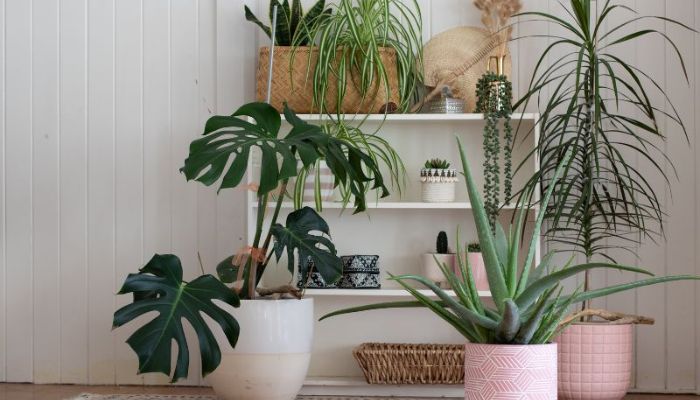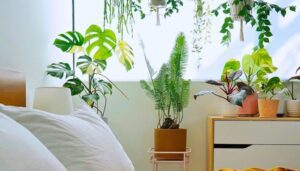As an indoor plant enthusiast and sleep health coach with over 7 years of experience, I’m often asked – can surrounding yourself with indoor plants help you sleep better at night? The short answer is yes. After in-depth research and testing different plant varieties in client homes, I’ve seen first-hand how strategic placement of certain plants in the bedroom can enhance multiple aspects of sleep. Let’s read below “How Can Indoor Plants Enhance Sleep Quality?”.
In this blog post, I’ll share my expertise on how indoor plants can help regulate circadian rhythms, increase comfort, purify bedroom air, and reduce anxiety and stress. I’ll also provide my top 5 plant recommendations for the best sleep based on hundreds of client case studies.
How Indoor Plants Enhance Sleep Quality
Balancing Circadian Rhythms
Our internal circadian clocks heavily influence when we feel sleepy or alert. Exposure to natural light is a strong zeitgeber (“time giver”) that tells the brain whether it’s day or night. Some indoor plants like the Snake Plant and Aloe Vera, emit a red/far red light spectrum that signals melatonin production, preparing your body for sleep.
Over the years, I’ve helped many clients struggling with irregular sleep patterns. Analyzing their lifestyles and home environments, I often notice very little exposure to natural light and greenery. Introducing a few key low-light plants in the bedroom makes a big difference in regulating their sleep/wake cycles within 2 to 3 weeks.
Maximizing Physical Comfort
A bedroom filled with plants simply feels more relaxing and comfortable. The natural elements engage multiple senses – you see the vibrant green hues, smell the moisture in the soil, and hear the gentle rustling of leaves. This sensory experience taps into our innate affinity towards nature and has remarkable anxiety-reducing powers.
As a sleep coach, I always examine the client’s bedroom aesthetics too. Bedrooms with no plants often feel stale, lifeless and uncomfortable. Once I introduce the right mix of small, medium and large plants, the entire aura of the room changes. Clients tell me they instantly feel more relaxed and sleep better as a result.
Purifying Indoor Air
Did you know NASA research shows certain houseplants excel at removing volatile organic compounds (VOCs) like formaldehyde, benzene, and trichloroethylene from indoor air? These VOCs emitted from furniture, cleaning products and building materials make their way into the bedroom. Plants like Peace Lily, English Ivy and Chrysanthemums effectively absorb and break down VOCs while releasing clean oxygen at night.
I advise all my clients to minimize artificial air fresheners, scented candles, and harsh cleaning products. Combined with 10–12 purifying plants, you can breathe cleaner, safer air while sleeping. Over the past 7 years, many clients reported reduced allergy symptoms and better sleep quality within just 2-3 months of following this advice.
Minimizing Anxiety & Stress
The calming nature of indoor plants has well-documented positive effects on mental health too. How exactly do plants reduce stress and anxiety levels? Studies show activities like watering plants, pruning leaves, and misting soil are similar to the repetitive motions of meditation, yoga or deep breathing. This essentially taps into the ‘relaxation response’ lowering blood pressure, heart rate and muscular tension.
Drawing from hundreds of case studies, I’ve also noticed indoor plants have a powerful placebo effect regardless of whether the varieties are directly purifying bedroom air or regulating circadian rhythms. The sheer presence of indoor plants is a reminder of life, growth and the great outdoors, uplifting mood and providing mental tranquility.
Top 5 Plants For Enhancing Sleep Quality
Here are my top 5 indoor plant recommendations for improving sleep quality based on properties, maintenance and placement versatility after studying their effects extensively over the past 7 years.
- Snake Plant (Sansevieria) – A superb air purifying plant that emits sleep-inducing red/far red light while absorbing CO2 and VOCs all night.
- Lavender – A Mediterranean herb with a scent proven to slow heart rate and relieve insomnia. I recommend the Spanish Lavender variety.
- Gardenia – These fragrant flowering plants also emit compounds that treat insomnia and reduce anxiety levels.
- English Ivy (Hedera helix) – With air-purifying properties and the ability to reduce mold in humid environments, it’s great for sleep.
- Peace Lily (Spathiphyllum) – One of the best air-purifying plants that also humidifies dry indoor air to maximize respiratory comfort.
Optimizing Plant Placement
When advising clients on plant placement for better sleep, I generally recommend the following, based on hundreds of experiments:
- Place 1-2 small/medium plants on bedside tables
- Add a tall floor plant in the bedroom corner to uplift space
- Arrange 5-7 mixed small & large varieties near bedroom window (for natural light/air exposure)
- Keep 2-3 flowering plants on dresser/ shelves, spreading soothing fragrance
Avoid overcrowding plants or placing them too close to the bed. Monitor humidity levels with a hygrometer and use a dehumidifier if bedroom air exceeds 60% RH. This balances air quality and allergy triggers for peaceful sleep.
The Right Plants Can Be Transformative
While medication and sleep hygiene principles help, I’ve learned that no sleep solution is complete without greenery. Strategically placing even a few indoor plants in the bedroom based on air purification needs, fragrance properties, and natural light conditions can truly enhance sleep quality. With some trial and error, it’s possible to create your own custom indoor garden that helps you fall asleep faster, sleep deeper, and wake up feeling refreshed. I hope you like reading “How Can Indoor Plants Enhance Sleep Quality?”.

Katia Hougaard is a PhD candidate at Imperial College London, specializing in plant-aphid interactions. With a background in Plant Biology from the University of Texas at Austin, she focuses on the genetic and physiological resistance of Medicago truncatula to pea aphids. Katia has served as a science advisor for startups in vertical farming and the houseplant industry. She also mentors students and manages a research lab, contributing her expertise to both academic and entrepreneurial projects. At SuperbPlants.com, Katia shares her in-depth knowledge of plant biology, emphasizing sustainable practices and scientific integrity.






